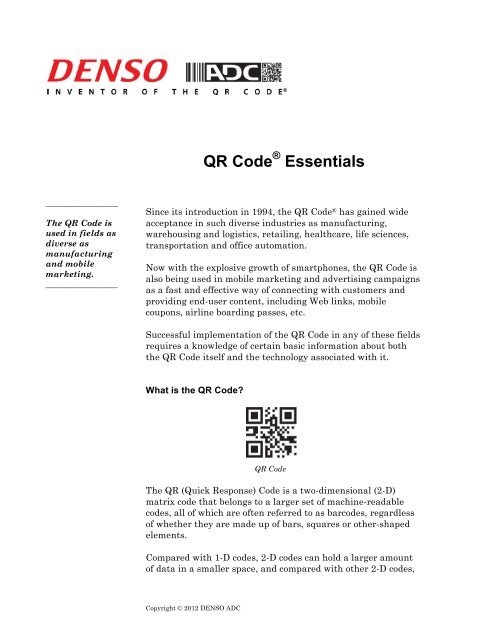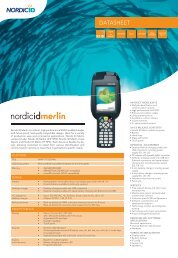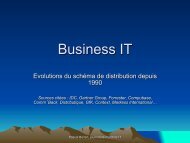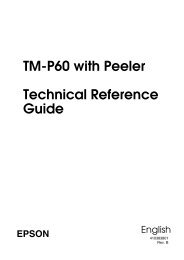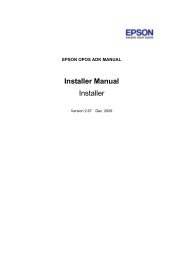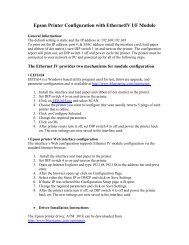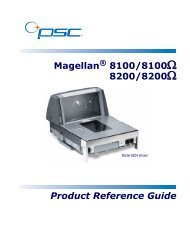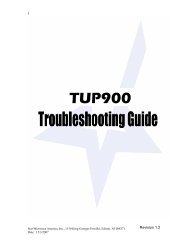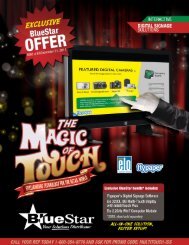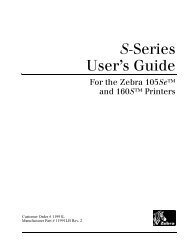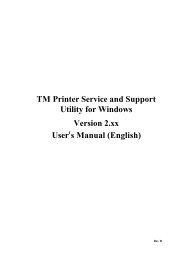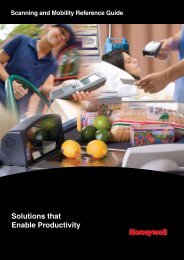DENSO ADC QR Code White Paper - BlueStar
DENSO ADC QR Code White Paper - BlueStar
DENSO ADC QR Code White Paper - BlueStar
You also want an ePaper? Increase the reach of your titles
YUMPU automatically turns print PDFs into web optimized ePapers that Google loves.
<strong>QR</strong> <strong>Code</strong> ® Essentials<br />
_________________<br />
The <strong>QR</strong> <strong>Code</strong> is<br />
used in fields as<br />
diverse as<br />
manufacturing<br />
and mobile<br />
marketing.<br />
_________________<br />
Since its introduction in 1994, the <strong>QR</strong> <strong>Code</strong> ® has gained wide<br />
acceptance in such diverse industries as manufacturing,<br />
warehousing and logistics, retailing, healthcare, life sciences,<br />
transportation and office automation.<br />
Now with the explosive growth of smartphones, the <strong>QR</strong> <strong>Code</strong> is<br />
also being used in mobile marketing and advertising campaigns<br />
as a fast and effective way of connecting with customers and<br />
providing end-user content, including Web links, mobile<br />
coupons, airline boarding passes, etc.<br />
Successful implementation of the <strong>QR</strong> <strong>Code</strong> in any of these fields<br />
requires a knowledge of certain basic information about both<br />
the <strong>QR</strong> <strong>Code</strong> itself and the technology associated with it.<br />
What is the <strong>QR</strong> <strong>Code</strong>?<br />
<strong>QR</strong> <strong>Code</strong><br />
The <strong>QR</strong> (Quick Response) <strong>Code</strong> is a two-dimensional (2-D)<br />
matrix code that belongs to a larger set of machine-readable<br />
codes, all of which are often referred to as barcodes, regardless<br />
of whether they are made up of bars, squares or other-shaped<br />
elements.<br />
Compared with 1-D codes, 2-D codes can hold a larger amount<br />
of data in a smaller space, and compared with other 2-D codes,<br />
Copyright © 2012 <strong>DENSO</strong> <strong>ADC</strong>
<strong>QR</strong> <strong>Code</strong> Essentials<br />
the <strong>QR</strong> <strong>Code</strong> can hold much more data still. In addition, an<br />
advanced error-correction method and other unique<br />
characteristics allow the <strong>QR</strong> <strong>Code</strong> to be read more reliably and<br />
at higher speeds than other codes.<br />
Like written language, barcodes are visual representations of<br />
information. Unlike language, however, which humans can<br />
read, barcodes are designed to be read and understood (decoded)<br />
by computers, using machine-vision systems consisting of<br />
optical laser scanners or cameras and barcode-interpreting<br />
software. The rules with which a barcode is constructed (its<br />
grammar) and the character set it uses (its alphabet) are called<br />
its symbology.<br />
How 1-D barcodes work<br />
_________________<br />
One-dimensional<br />
(1-D) barcodes<br />
contain<br />
information in<br />
only the<br />
horizontal<br />
direction.<br />
_________________<br />
There are two basic types of barcode symbologies: onedimensional,<br />
or linear, and two-dimensional.<br />
One-dimensional (1-D) barcodes, such as the Universal Product<br />
<strong>Code</strong> (UPC) commonly seen on the price tags and packages of<br />
products in a retail or grocery store, consist of a series of<br />
vertical bars and spaces. They are classified as one-dimensional<br />
because the information contained in them is communicated<br />
only by the difference in their horizontal dimension—the width<br />
of the bars and spaces—and their position from left to right.<br />
To barcode-reading software, both of these 1-D barcodes are identical.<br />
Changing the height of the bars does not change the information they contain.<br />
Differences in the second, vertical dimension of the bars and<br />
spaces—whether they are taller or shorter—does not matter; all<br />
that counts is how wide they are and what order they are placed<br />
in.<br />
From 1-D to 2-D codes<br />
After the commercial introduction of 1-D barcodes in 1966, they<br />
quickly gained widespread acceptance. In time, however,<br />
demand grew for new types of codes that could hold more<br />
Copyright © 2012 <strong>DENSO</strong> <strong>ADC</strong> 2
<strong>QR</strong> <strong>Code</strong> Essentials<br />
information and use more character types, yet occupy a smaller<br />
space.<br />
Attempts were consequently made to increase the amount of<br />
data contained in barcodes by increasing the number of bars or<br />
creating multiple-barcode layouts. These efforts, however,<br />
resulted in a larger barcode area, complicated reading<br />
requirements and increased printing costs.<br />
To solve these problems, two-dimensional (2-D) codes were<br />
developed, first as stacked barcodes, which repeat the same<br />
linear symbology vertically, and then as matrix codes, composed<br />
of small, symmetrical elements arranged in a square or<br />
rectangle.<br />
Multiple-barcode 2-D stacked barcode 2-D matrix code<br />
layout<br />
Because 2-D matrix codes contain information in both the<br />
horizontal and vertical direction, they met the need for high<br />
data density and small size, yet further improvements were still<br />
to follow, including those introduced by the <strong>QR</strong> <strong>Code</strong>.<br />
The following table summarizes the features and characteristics<br />
of some typical 2-D codes.<br />
<strong>QR</strong> <strong>Code</strong> PDF417 DataMatrix Maxi<strong>Code</strong><br />
Data<br />
capacity<br />
Developer<br />
<strong>DENSO</strong> Wave<br />
Symbol<br />
Technologies<br />
RVSI<br />
Acuity CiMatrix<br />
Type Matrix Stacked barcode Matrix Matrix<br />
Numeric 7,089 2,710 3,116 138<br />
Alphanumeric 4,296 1,850 2,355 93<br />
Binary 2,953 1,018 1,556 -<br />
Japanese, Chinese or<br />
Korean characters<br />
Main features<br />
Main applications<br />
1,817 554 778 -<br />
Large capacity,<br />
small size, highspeed<br />
scanning<br />
All categories<br />
Large capacity<br />
Office<br />
automation<br />
Small size<br />
Factory<br />
automation<br />
UPS<br />
High-speed<br />
scanning<br />
Logistics<br />
Standards AIM, JIS, ISO AIM, ISO AIM, ISO AIM, ISO<br />
Copyright © 2012 <strong>DENSO</strong> <strong>ADC</strong> 3
<strong>QR</strong> <strong>Code</strong> Essentials<br />
How the <strong>QR</strong> <strong>Code</strong> works<br />
_________________<br />
The <strong>QR</strong> <strong>Code</strong> is a<br />
2-D matrix<br />
barcode that<br />
contains<br />
information in<br />
both the<br />
horizontal and<br />
vertical<br />
dimension.<br />
_________________<br />
Unlike 1-D barcodes, the <strong>QR</strong> <strong>Code</strong> is a 2-D matrix code that<br />
conveys information not by the size and position of bars and<br />
spaces in a single (horizontal) dimension, but by the<br />
arrangement of its dark and light elements, called “modules,” in<br />
columns and rows, i.e. in both the horizontal and vertical<br />
directions.<br />
Each dark or light module of a <strong>QR</strong> <strong>Code</strong> symbol—a specific<br />
instance of a code—represents a 0 or 1, thus making it machineintelligible.<br />
The <strong>QR</strong> <strong>Code</strong> modules perform several functions: Some contain<br />
the actual data itself, while others are grouped into various<br />
function patterns that improve reading performance and allow<br />
symbol alignment, error correction and distortion compensation.<br />
The timing pattern lets the scanning device know the size of the<br />
symbol. There is also a required “quiet zone,” a four-modulewide<br />
buffer area containing no data, to ensure that surrounding<br />
text or markings are not mistaken for <strong>QR</strong> <strong>Code</strong> data.<br />
Conventional 2-D matrix codes required a considerable amount<br />
of time to be spent searching a symbol’s code to determine its<br />
angle of orientation, position (x and y coordinates) and size.<br />
To address this problem, the <strong>QR</strong> <strong>Code</strong> was designed with<br />
special position-detection patterns located in three corners of<br />
each symbol. The patterns have a symmetrical scan-line ratio of<br />
1:1:3:1:1, which allows them to be scanned from any direction<br />
Copyright © 2012 <strong>DENSO</strong> <strong>ADC</strong> 4
<strong>QR</strong> <strong>Code</strong> Essentials<br />
within a full 360 degrees. In addition, the positional<br />
relationship of the patterns allows quick access to the relevant<br />
angle, position and size information contained in the code’s<br />
periphery.<br />
As a result, the <strong>QR</strong> <strong>Code</strong> does not require lengthy code<br />
searching, enabling reading speeds 20 times faster than those of<br />
conventional matrix codes. Also, searching the positiondetection<br />
patterns can be performed by the scanning hardware,<br />
further increasing overall speed by allowing image reading and<br />
data processing to be carried out simultaneously.<br />
<strong>QR</strong> <strong>Code</strong> Symbol Versions<br />
<strong>QR</strong> <strong>Code</strong>s can be generated in 40 different symbol versions,<br />
from 21 x 21 modules (version 1) to 177 x 177 modules (version<br />
40).<br />
Each higher symbol version has 4 additional modules per side<br />
(16 additional modules per symbol), and can contain a<br />
proportionally larger amount of data. The maximum amount of<br />
data that can be contained by a given symbol is determined by<br />
its version, type of characters and error-correction level.<br />
<strong>QR</strong> <strong>Code</strong> Error Correction<br />
The <strong>QR</strong> <strong>Code</strong>’s powerful error-correction capability is achieved<br />
by adding Reed-Solomon codes, a widely used mathematical<br />
error-correction method, to the original data. This allows a <strong>QR</strong><br />
<strong>Code</strong> symbol to be read even if it is dirty or damaged.<br />
Four levels of error correction are available. The higher the<br />
level, the greater the error correction, but also the larger the<br />
<strong>QR</strong> <strong>Code</strong> version.<br />
Copyright © 2012 <strong>DENSO</strong> <strong>ADC</strong> 5
<strong>QR</strong> <strong>Code</strong> Essentials<br />
Error-Correction<br />
Level<br />
Approximate Amount<br />
of Correction<br />
L 7%<br />
M 15%<br />
Q 25%<br />
H 30%<br />
When selecting the level of error correction, environmental<br />
conditions as well as the desired size of the <strong>QR</strong> <strong>Code</strong> symbol<br />
need to be taken into account.<br />
For example, Level Q (25% error correction) or H (30%) may be<br />
required for factories or other applications where the <strong>QR</strong> <strong>Code</strong><br />
is likely to become dirty or damaged. For clean environments<br />
and codes containing a large amount of data, Level L (7%) may<br />
be selected. In general, Level M (15%) is most frequently used.<br />
<strong>QR</strong> <strong>Code</strong> Benefits<br />
_________________<br />
The <strong>QR</strong> <strong>Code</strong><br />
combines fast<br />
scanning, highcapacity<br />
storage<br />
and small size.<br />
_________________<br />
The <strong>QR</strong> <strong>Code</strong>’s unique design gives it many unique advantages<br />
and benefits, including:<br />
Fast, omnidirectional scanning: Position-detection patterns<br />
in three corners of a symbol allow the <strong>QR</strong> <strong>Code</strong> to be read from<br />
any angle within 360 degrees, eliminating the need to align the<br />
scanner with the code symbol. The position-detection patterns<br />
also eliminate any background interference, ensuring stable<br />
high-speed reading.<br />
High-capacity data storage: A single <strong>QR</strong> <strong>Code</strong> symbol can<br />
contain up to 7,089 numerals—over 200 times the amount of<br />
data as a traditional 1-D barcode.<br />
A <strong>QR</strong> <strong>Code</strong> symbol of this size can<br />
hold 300 alphanumeric characters.<br />
Copyright © 2012 <strong>DENSO</strong> <strong>ADC</strong> 6
<strong>QR</strong> <strong>Code</strong> Essentials<br />
Small size: A <strong>QR</strong> <strong>Code</strong> can hold the same amount of data<br />
contained in a 1-D barcode in only one-tenth the space.<br />
Error correction: Depending on the error-correction level<br />
chosen, a <strong>QR</strong> <strong>Code</strong> symbol can be decoded even if up to 30% of<br />
the data is dirty or damaged.<br />
Many types of data: The <strong>QR</strong> <strong>Code</strong> can handle numerals,<br />
alphabetic characters, symbols, Japanese, Chinese or Korean<br />
characters and binary data.<br />
Distortion compensation: A <strong>QR</strong> <strong>Code</strong> symbol can be read<br />
even if its image is on a curved or otherwise distorted surface.<br />
Linkability (Structured Append): A <strong>QR</strong> <strong>Code</strong> symbol can be<br />
divided into up to 16 smaller symbols to fit long, narrow spaces.<br />
The smaller symbols are read as a single code, regardless of the<br />
order in which they are scanned.<br />
The four <strong>QR</strong> <strong>Code</strong> symbols in the bottom row contain<br />
the same data as the symbol in the top row.<br />
Copyright © 2012 <strong>DENSO</strong> <strong>ADC</strong> 7
<strong>QR</strong> <strong>Code</strong> Essentials<br />
Direct Marking: The <strong>QR</strong> <strong>Code</strong>’s high degree of readability<br />
under low-contrast conditions allows printing, laser etching or<br />
dot-pin marking (DPM) of a symbol directly onto a part or<br />
product.<br />
Uses of the <strong>QR</strong> <strong>Code</strong><br />
Although the <strong>QR</strong> <strong>Code</strong> was originally designed to track<br />
automotive components and systems through the<br />
manufacturing process and distribution supply chain, it has<br />
rapidly spread to virtually every other area where traditional<br />
barcodes are used, as well as some entirely new ones.<br />
Typical applications include:<br />
_________________<br />
The use of the<br />
<strong>QR</strong> <strong>Code</strong> in<br />
mobile<br />
marketing<br />
allows direct<br />
communication<br />
between<br />
advertisers and<br />
smartphone<br />
users.<br />
_________________<br />
• Manufacturing<br />
Product traceability<br />
Process control<br />
Order and time tracking<br />
Inventory and equipment management<br />
• Warehousing and logistics<br />
Item tracking<br />
• Retailing<br />
Point-of-purchase product identification<br />
Sales management<br />
Inventory control<br />
• Healthcare<br />
Medical records management<br />
Patient identification<br />
Medication tracking<br />
Equipment and device tracking<br />
• Life sciences<br />
Specimen tracking<br />
• Transportation<br />
Fleet management<br />
Ticketing and boarding passes<br />
• Office automation<br />
Document management<br />
• Marketing and advertising<br />
Mobile marketing<br />
Electronic tickets, coupons, payments and loyalty<br />
programs<br />
The newest and most innovative uses of the <strong>QR</strong> <strong>Code</strong> are in<br />
marketing and advertising.<br />
Copyright © 2012 <strong>DENSO</strong> <strong>ADC</strong> 8
<strong>QR</strong> <strong>Code</strong> Essentials<br />
Mobile marketing has been very popular in Japan, Korea and<br />
the Netherlands for several years, and has recently seen rapid<br />
growth in North America, where the <strong>QR</strong> <strong>Code</strong> is increasingly<br />
appearing in print and online advertising, as well as on signs,<br />
billboards, posters, business cards, clothing and other items.<br />
By scanning a <strong>QR</strong> <strong>Code</strong> with a smartphone, consumers can be<br />
connected to a relevant Web page or receive targeted marketing<br />
messages such as a special offer, discount coupon, product or<br />
store information, etc.<br />
In addition, scanners are now available that are specially<br />
designed to read a <strong>QR</strong> <strong>Code</strong> displayed on the LCD screen of a<br />
smartphone. The code can contain a user’s electronic ticket or<br />
coupon, electronic payment information, loyalty-program<br />
identification, etc.<br />
Generating <strong>QR</strong> <strong>Code</strong>s<br />
_________________<br />
To ensure that a<br />
<strong>QR</strong> <strong>Code</strong> will be<br />
readable by the<br />
highest<br />
percentage of<br />
devices, only<br />
code-generating<br />
software<br />
compliant with<br />
ISO Standard<br />
18004 should be<br />
used.<br />
_________________<br />
As the inventor of the <strong>QR</strong> <strong>Code</strong> and owner of the <strong>QR</strong> <strong>Code</strong><br />
trademark, <strong>DENSO</strong> Wave Incorporated has allowed the patents<br />
for the code to be freely available to the public. Consequently,<br />
many websites now feature online <strong>QR</strong> <strong>Code</strong> generators or<br />
downloadable code-generating software.<br />
Such code generators and software are not certified by the<br />
International Organization for Standardization (ISO), however,<br />
so there is no way of telling if they adhere to the relevant ISO<br />
Standard 18004, which is based on the <strong>DENSO</strong> Wave patent.<br />
As a result, the code symbols they create may not be readable<br />
by all devices or the reading quality may be reduced.<br />
(An easy test is to create the same code symbol with two or<br />
more online generators and compare the results. Differences in<br />
the arrangement of the modules—similar to the differences in<br />
language translation—will be immediately apparent.)<br />
Of particular concern is the fact that non-ISO-compliant code<br />
generators do not determine the minimum printable size of a<br />
given <strong>QR</strong> <strong>Code</strong> symbol. If a symbol is printed at a size that is<br />
below the ISO-specified minimum—which takes into account<br />
the amount of data contained in that symbol, the symbol<br />
version and the resolution of the printing device—readability<br />
will be dramatically reduced.<br />
Copyright © 2012 <strong>DENSO</strong> <strong>ADC</strong> 9
<strong>QR</strong> <strong>Code</strong> Essentials<br />
Using <strong>QR</strong> <strong>Code</strong>-generating software that is not ISO compliant<br />
can be especially problematic if the <strong>QR</strong> <strong>Code</strong> is to be read by<br />
smartphones, whose quality may greatly vary. Also, the <strong>QR</strong><br />
<strong>Code</strong>-reading software used by smartphones, like codegenerating<br />
software, is not necessarily based on ISO<br />
specifications.<br />
Only ISO-compliant <strong>QR</strong> <strong>Code</strong>-generating software can ensure<br />
maximum symbol readability and specify the minimum printable<br />
size for a given symbol.<br />
To ensure that a <strong>QR</strong> <strong>Code</strong> will be successfully read by the<br />
highest percentage of devices, therefore, it is essential to use<br />
code-generating software offered only by a reputable<br />
manufacturer who can be trusted to comply with ISO<br />
specifications.<br />
_________________<br />
Ergonomic<br />
scanner designs<br />
reduce operator<br />
fatigue, increase<br />
productivity.<br />
_________________<br />
Reading <strong>QR</strong> <strong>Code</strong>s: 5 things to look for in a 2-D scanner or<br />
terminal<br />
1. High-speed reading: Faster scanning and the ability to<br />
scan barcodes from a distance increase operator efficiency. Look<br />
for devices with advanced CCD scanning technology, which<br />
enables even high-density or poorly printed barcodes to be read<br />
at high speed and from a distance.<br />
Copyright © 2012 <strong>DENSO</strong> <strong>ADC</strong> 10
<strong>QR</strong> <strong>Code</strong> Essentials<br />
2. Ease of use: Lightweight, ergonomic designs, featuring large<br />
display screens and easy-to-hold grips, reduce operator fatigue,<br />
a key factor in productivity.<br />
3. Durability: In the field, hand-held scanners and terminals<br />
are vulnerable to harsh environments and rough handling,<br />
including being bumped or dropped. Devices featuring rugged,<br />
drop-resistant construction and resistance to water and dust<br />
protect your equipment investment.<br />
4. Long battery life: Scanners are available with power-saving<br />
features that result in longer operating time, eliminating<br />
frequent, time-consuming battery changes.<br />
5. Experience and reputation of the manufacturer: Look<br />
for a manufacturer that has established itself as an industry<br />
leader and innovator, and whose products have stood the test of<br />
time.<br />
About <strong>DENSO</strong> <strong>ADC</strong><br />
<strong>DENSO</strong> <strong>ADC</strong> is the Americas sales arm of <strong>DENSO</strong> Wave<br />
Incorporated, which pioneered CCD technology and invented<br />
the revolutionary <strong>QR</strong> <strong>Code</strong>. <strong>DENSO</strong> Wave is among the world’s<br />
largest manufacturers of mobile data capture systems.<br />
The company offers a wide range of advanced-technology,<br />
handheld 1-D and 2-D terminals and scanners. These products<br />
feature industry-leading, lightweight, ergonomic designs;<br />
rugged technology that can stand up to the roughest handling<br />
and harshest environments; superior resistance to water and<br />
dust exposure; power-saving advantages that enable longer<br />
operating time; communication via Bluetooth, USB, serial or<br />
keyboard interfaces, or live communication via 802.11b,<br />
Bluetooth or GPRS; and lower cost of ownership.<br />
For more information, visit the <strong>DENSO</strong> <strong>ADC</strong> website at<br />
www.denso-adc.com.<br />
<strong>DENSO</strong> <strong>ADC</strong> is a brand of <strong>DENSO</strong> Corporation, headquartered<br />
in Kariya, Aichi prefecture, Japan. <strong>DENSO</strong> is a leading global<br />
automotive supplier of advanced technology, systems and<br />
components in the areas of thermal, powertrain control, electric,<br />
electronics and information and safety. Its customers include all<br />
the world’s major carmakers. Worldwide, the company has more<br />
Copyright © 2012 <strong>DENSO</strong> <strong>ADC</strong> 11
<strong>QR</strong> <strong>Code</strong> Essentials<br />
than 200 subsidiaries and affiliates in 35 countries and regions<br />
(including Japan) and employs approximately 120,000 people.<br />
Consolidated global sales for the fiscal year ending March 31,<br />
2011, totaled US$37.7 billion. Last fiscal year, <strong>DENSO</strong> spent<br />
9.3 percent of its global consolidated sales on research and<br />
development. <strong>DENSO</strong> common stock is traded on the Tokyo and<br />
Nagoya stock exchanges.<br />
In North America, <strong>DENSO</strong> employs 13,000 people with<br />
consolidated sales totaling US$6.4 billion for the fiscal year<br />
ended March 31, 2011.<br />
Copyright © 2012 <strong>DENSO</strong> <strong>ADC</strong> 12<br />
<strong>QR</strong> <strong>Code</strong>® is a registered trademark of <strong>DENSO</strong> Wave Incorporated.


